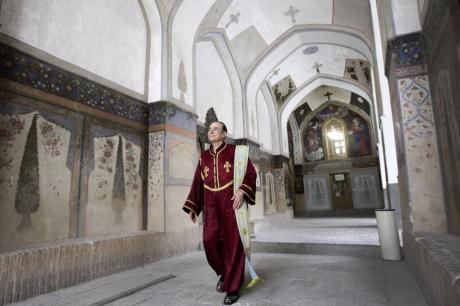
It’s January 6th. Yet another snowy winter afternoon in Isfahan, but somehow curiously unlike the rest. A blanket of white fluff cloaks the medieval metropolis and all of its timeless splendor, shielding the antique avenues, turquoise-dome rooftops, cypress tree colonnades, and magnificent bridge arcades from the yearning eyes of even the most impassioned beholder. The puffy white shrouds gather to form a crown atop the Zagros mountains in the distance, setting the scene of a glorious winter wonderland. At midday a few chariots prance through the plaza of the Meydân while the bazaar barons sit reclined, playfully puffing their waterpipes and sipping hot black tea over conversation.
Across the river, a crowd of cheerful, fur-clad folks gathers at the foot of a burgeoning cathedral, summoned there by the alluring sirens of church bells. One by one, amidst a sea of incessant kissing and well-wishing, families scurry in to take photos next to the lavishly decorated pine tree before lighting candles and reading prayers from the Bible. Perhaps some of the little ones are still sleepy from the late-night fireworks, or nostalgically thinking back to the gifts they had asked for atop Dzmer Pap’s (Santa Claus) lap weeks before. Surely nothing a holiday feast’s worth of harissa and mouth-watering Persian food alongside family can’t remedy. The priest breaks bread and pours homemade red wine for his parishioners, and soon the adults are off on the quest to create the perfect dinner party. This is a portrait of a typical Christmas Day among the Armenians of Isfahan, not far off from their brethren in Tehran, Tabriz, Fereydunshahr (P’eria), Urmia, Hamedan, and Los Angeles.
The ~120,000 Armenians remaining in Iran today are designated two seats in the Iranian Parliament (Majles) and granted freedom of worship, as well as the right to a Christian, Armenian-language education in private secondary schools. And while the Armenians are certainly adored by their Iranian compatriots at large–with whom their kinship dates back at least nominally to the Aryan invasion of the Near East–they are often overlooked in spite of their centuries-long contributions to their homeland. After all, Armenians were paramount in opening up Persia to the West before the age of Imperialism, and they introduced a number of both Western and Eastern innovations to Iran including European firearms (1722) and the printing press (1636). It was Iranian Armenians who attracted Christian evangelists to open European language schools, including the forerunner to the French-language Jeanne d’Arc Academy in Tehran; who received and hosted European visitors to the capital throughout the Safavid period; and who recruited European instructors to teach at Persia’s first modern institute of higher learning, Dâr ol-Funûn (est. 1851).
Throughout the 19th century, Iranian Armenian tailors and jewelers introduced European fashions, and Armenian photographers and filmmakers were among the first in those professions. A hero from among their ranks, Yeprem Khan, played a pivotal role in the Iranian Constitutional Revolution of 1905, and young Armenians were “martyred” alongside their Muslim brothers during the Iran-Iraq War. Perhaps some of us are more familiar with the big Iranian Armenian names in the Persian music industry like Vigen, Andy, Helen, Martik, Serjik, Elcid, or sports luminaries such as footballer Andranik Teymourian and worldwide tennis idol Andre Agassi, or even Iran’s first female astronomer and physicist, Alenush Terian. It is in light of all of this that the people most aptly call themselves Parskahay (“Perso-Armenian”), as distinct, long-time actors in the dynamic but inclusive nation they call home.
But perhaps the most fascinating historical narrative of Iranian Armenians takes us back four centuries, to the Safavid period. Shah Abbas I (ruled 1587-1629) is one of the most celebrated Safavid Kings, in part due to his vision of geopolitical centralization and his reconquest of lost peripheral provinces from the neighboring Ottomans and Uzbeks. But among his most unique contributions was the establishment of a world-class commercial district in his new capital city, Isfahan, wherefrom Iranian silk was exchanged for European silver. What’s more, this district was governed by a private land-owning merchant oligarchy comprised of an independent council and a Christian provost (kalântar) appointed by the Shah, whose vision it was to bypass the land route through the Ottoman Empire and redirect the silk trade through central Iran and the Persian Gulf. It was here in Isfahan that, not unlike the Sephardic Jews of the Ottoman Empire, a group of elite Armenian silk traders were brought to serve as the backbone of the Safavid economy and establish a sphere of commercial and financial transactions in over a hundred cities spanning from Burma, India, and China to Russia, the Ottoman Empire, Venice, Amsterdam, Sweden, and Mexico.
For the entire article, please visit: http://ajammc.wordpress.com/2012/10/23/the-bridge-…
***
Interested in dating Armenian singles? Click here to view all sites.






